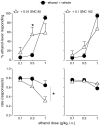Opioid receptors and the discriminative stimulus effects of ethanol in squirrel monkeys: Mu and delta opioid receptor mechanisms
- PMID: 20940013
- PMCID: PMC2997855
- DOI: 10.1016/j.ejphar.2010.09.064
Opioid receptors and the discriminative stimulus effects of ethanol in squirrel monkeys: Mu and delta opioid receptor mechanisms
Abstract
Mu and delta opioid receptors modulate the reinforcing effects of ethanol, however, their role in the subjective effects of ethanol is not well understood. This study evaluated the contribution of mu and delta opioid receptors to the subjective effects of ethanol using drug discrimination procedures. Monkeys were trained to discriminate ethanol from saline under a schedule of food delivery. In tests, ethanol engendered increases in drug-lever responding, reaching a maximum of >80%. The mu opioid receptor agonists fentanyl and buprenorphine and the delta opioid receptor agonists SNC 80 and SNC 162 did not substitute for the discriminative stimulus effects of ethanol. As pretreatments, the full agonists fentanyl and SNC 80 enhanced the effects of low doses of ethanol and fentanyl attenuated the effects of the ethanol training dose. Although the possibility of pharmacological antagonism of the effects of ethanol cannot be ruled out, a more likely alternative is that the diminished effects of ethanol were due to perceptual masking of the ethanol stimulus. In contrast, the partial agonists buprenorphine and SNC 162 did not alter ethanol's effects. Finally, the discriminative stimulus effects of ethanol were attenuated following administration of presumably mu-selective doses of the antagonist naltrexone, but not after administration of the delta opioid receptor antagonist naltrindole. The ability of naltrexone to block the discriminative stimulus effects of ethanol likely reflects its capacity to attenuate ethanol-induced increases in endogenous opioids, in particular beta-endorphin, because attenuation of the ethanol stimulus was not accompanied by significant suppression of response rate.
Copyright © 2010 Elsevier B.V. All rights reserved.
Figures





Similar articles
-
Opioid enhancement of the discriminative stimulus effects of cocaine: evidence for involvement of mu and delta opioid receptors.Psychopharmacology (Berl). 1998 Nov;140(2):217-24. doi: 10.1007/s002130050760. Psychopharmacology (Berl). 1998. PMID: 9860113
-
Involvement of mu-, delta- and kappa-opioid receptor subtypes in the discriminative-stimulus effects of delta-9-tetrahydrocannabinol (THC) in rats.Psychopharmacology (Berl). 2005 Jun;179(4):804-12. doi: 10.1007/s00213-004-2118-x. Epub 2004 Dec 24. Psychopharmacology (Berl). 2005. PMID: 15619107
-
Discriminative stimulus effects of the mixed-opioid agonist/antagonist dezocine: cross-substitution by mu and delta opioid agonists.J Pharmacol Exp Ther. 1997 Dec;283(3):1009-17. J Pharmacol Exp Ther. 1997. PMID: 9399970
-
Role of mu and delta opioid receptors in alcohol drinking behaviour.Curr Drug Abuse Rev. 2008 Jun;1(2):239-52. doi: 10.2174/1874473710801020239. Curr Drug Abuse Rev. 2008. PMID: 19630722 Review.
-
Opioid ligands with mixed mu/delta opioid receptor interactions: an emerging approach to novel analgesics.AAPS J. 2006 Mar 10;8(1):E118-25. doi: 10.1208/aapsj080114. AAPS J. 2006. PMID: 16584118 Free PMC article. Review.
Cited by
-
Pharmacological traits of delta opioid receptors: pitfalls or opportunities?Psychopharmacology (Berl). 2013 Jul;228(1):1-18. doi: 10.1007/s00213-013-3129-2. Epub 2013 May 7. Psychopharmacology (Berl). 2013. PMID: 23649885 Free PMC article. Review.
-
Discriminative Stimulus Effects and Metabolism of Ethanol in Rhesus Monkeys.Alcohol Clin Exp Res. 2019 Sep;43(9):1909-1917. doi: 10.1111/acer.14142. Epub 2019 Jul 16. Alcohol Clin Exp Res. 2019. PMID: 31237691 Free PMC article.
-
Discriminative stimulus and hypothermic effects of some derivatives of the nAChR agonist epibatidine in mice.Psychopharmacology (Berl). 2014 Dec;231(23):4455-66. doi: 10.1007/s00213-014-3589-z. Epub 2014 May 7. Psychopharmacology (Berl). 2014. PMID: 24800895 Free PMC article.
-
Evaluation of morphine-like effects of the mixed mu/delta agonist morphine-6-O-sulfate in rats: Drug discrimination and physical dependence.Pharmacol Res Perspect. 2018 Jun 19;6(4):e00403. doi: 10.1002/prp2.403. eCollection 2018 Jul. Pharmacol Res Perspect. 2018. PMID: 29930811 Free PMC article.
-
Modulation of sensitivity to alcohol by cortical and thalamic brain regions.Eur J Neurosci. 2016 Oct;44(8):2569-2580. doi: 10.1111/ejn.13374. Epub 2016 Sep 8. Eur J Neurosci. 2016. PMID: 27543844 Free PMC article.
References
-
- Altshuler HL, Applebaum E, Shippenberg TS. The effects of opiate antagonists on the discriminative stimulus properties of ethanol. Pharmacol Biochem Behav. 1981;14:97–100. - PubMed
-
- Bowen CA, Gatto GJ, Grant KA. Assessment of the multiple discriminative stimulus effects of ethanol using an ethanol-pentobarbital-water discrimination in rats. Behav Pharmacol. 1997;8:339–352. - PubMed
-
- Codd EE, Carson JR, Colburn RW, Stone DJ, Van Besien CR, Zhang SP, Wade PR, Gallantine EL, Meert TF, Molino L, Pullan S, Razler CM, Dax SL, Flores CM. JNJ-20788560 [9-(8-azabicyclo[3.2.1]oct-3-ylidene)-9H-xanthene-3-carboxylic acid diethylamine], a selective delta opioid receptor agonist, is a potent and efficacious antihyperalgesic agent that does not produce respiratory depression, pharmacologic tolerance, or physical dependence. J Pharmacol Exp Ther. 2009;329:241–251. - PubMed
Publication types
MeSH terms
Substances
Grants and funding
LinkOut - more resources
Full Text Sources
Research Materials

